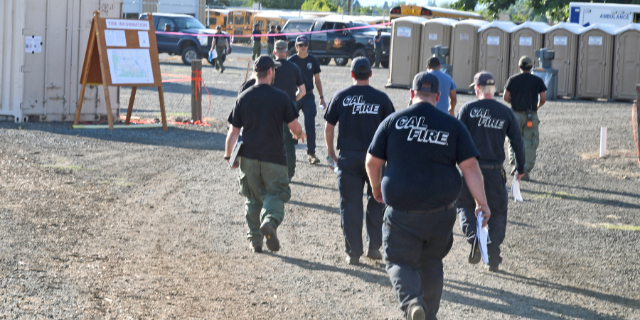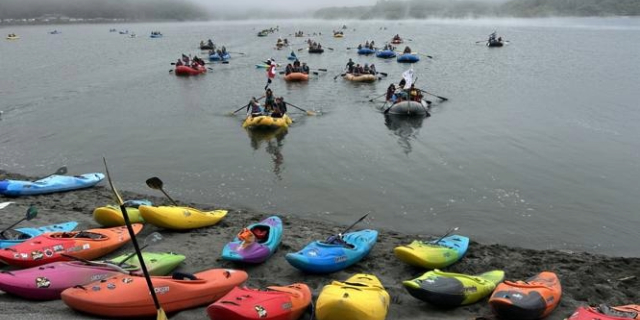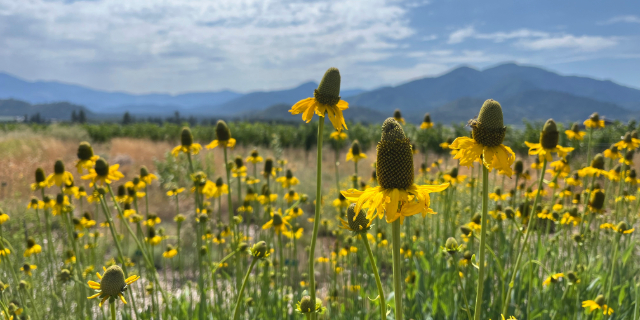Commercial logging to protect against wildfire begins in Applegate Valley
Published 11:15 am Monday, December 11, 2023

- Josh Budziak, restoration design and implementation specialist with the Lomakatsi Restoration Project, talks on Friday on U.S. Forest Service land south of Ruch about commercial logging about to take place there to protect against severe wildfire.
Wildfire mitigation work on federal forest land in the 52,000-acre upper Applegate River watershed southwest of Medford is entering a new phase with the start up of commercial logging operations.
Trending
The work, undertaken as a component of the ongoing Upper Applegate Watershed Restoration Project, is spearheaded by the U.S. Forest Service and includes the removal of brush and smaller trees along with the use of low-intensity fire. But it has now expanded to include the logging of trees that are an average of 12 inches in diameter and range from 8-27 inches in diameter.
The logging, known as commercial logging because it involves the sale of timber, will help offset the cost of other project work. It began in the past few weeks on 878 acres south of Ruch and entails the felling of selected trees to be removed by helicopter in coming weeks. Timberline Helicopters will do the hauling, with the logs going to a Murphy Company mill.
Trees on another 493 acres are expected to be commercially logged and removed via ground operations in coming months, with those operations continuing through April and then again next fall and winter.
Trending
The logging, which will leave behind the largest trees, will have the dual benefit of reducing competition between trees while lessening the risk of high-intensity wildfire sweeping through an area. Some stands to be logged are now densely packed tree plantations on land logged decades ago and then replanted.
The commercial logging, which might not be popular with everyone, helped prompt a public field trip on Friday to two commercial logging locations in the mountains above the U.S. Forest Service Star Ranger Station south of Ruch. About 30 people attended, most of them federal agency personnel and project participants, including personnel with the Lomakatsi Restoration Project, The Nature Conservancy and the Southern Oregon Forest Restoration Collaborative.
Lomakatsi, a 27-year-old Ashland-based nonprofit organization whose work includes brush removal and tree thinning, is a key participant in the work. Marko Bey, Lomakatsi’s founder and executive director, said forest health and not logging is the driving force behind the years-in-the-making watershed restoration project.
“This is not a healthy forest,” he said, while driving his rig to a dense stand of hillside timber marked for logging.
In Bey’s pickup truck was Belinda Brown, tribal partnership director for Lomakatsi, who said indigenous people used fire to maintain habitat that supported forest life and cultural ways. Those peoples were the original forest managers, until driven out.
“People were removed,” she said. “They kept the fire on the land.”
For more than a century now, the practice has been to fight wildfire, but that has led to a buildup of low-level woody debris, small trees and brush that feeds wildfire. Drought, global warming and tree plantations added more fuel to the fire.
Logging used to be king in southwestern Oregon, but times have changed, not always easily. Forest jobs have gone away in the name of wildlife and water quality protection, although some new jobs were created to address mounting concerns about increasing large, frequent wildfires.
Jennifer Sanborn, district ranger for the Forest Service in the upper Applegate watershed, spoke to the tour group. She said 300 people once worked for the Siskiyou National Forest, but that only 150 now work for the combined Rogue River-Siskiyou National Forest. She said there’s work to be done with the help of others, including tribes and watershed organizations.
“We were used to just doing our own thing,” she said. “We need to be more collaborative.”
That collaboration is working, she said.
“It’s just made our projects better. It just takes more time.”
Sanborn, whose background is in wildlife biology, spoke where the group stopped on a forest road overlooking a steep ravine where trees were marked for logging. She noted that terrain in the area was difficult for forest workers and wildland firefighters.
“I haven’t found anything flat yet,” she said.
Plans call for the commercial logging there to leave behind groupings of trees, instead of the densely packed tree plantation there now.
“It’s just so homogenous,” Sanborn said, describing the stand as it exists now. “It’ll be more of a mosaic.”
The plan is to leave behind about 80 trees per acre where about 200 trees an acre now stand.
“We need to lower the density,” said Darren Borgias of The Nature Conservancy, who was along on the tour.
To get the work done, the Forest Service has signed stewardship agreements with partner organizations like Lomakatsi, which brings in expertise and some of its own funding.
“It’s like a co-management project,” said Bey, the Lomakatsi director.
The work represents middle ground between environmentalists and loggers, he said.
“The radical middle.”
The sale of the logged timber will offset some, but not all, commercial logging operations costs. Those costs are about $2.2 million, including costs for felling, yarding and hauling, while revenue from the sale of the timber will yield about $2 million.
“It’s not particularly profitable,” Sanborn said. “This is a negative sale.”
“It needs to be done,” she added.
Future funding is uncertain, including funding for continued prescribed burning every 5-10 years to maintain resiliency. Per-acre costs for subsequent treatments are expected to be less expensive than the initial treatments now taking place
“Regular maintenance by fire,” said Terry Fairbanks, executive director of the Southern Oregon Forest Restoration Collaborative, one of the project partners. “It’s expensive. We’ve got to find the money.”
Interestingly, one of indicators of how well the work improves forest health will be the abundance of birds. Birds react quickly to their environment. The Klamath Bird Observatory is helping to survey bird populations there, before and after treatments.
“Bird is the word,” said Kyle Sullivan, a spokesman for the Bureau of Land Management, which manages properties within the watershed.
In all, the watershed plan calls for treatments on 18,000 acres of the watershed’s 52,000 acres. The work under way or already completed will treat just a fraction of that 18,000.
Thinning of non-commercial timber began in 2021 and is expected to continue for about two more years, including pile burning, for an initial total of 2,946 acres. The additional 1,371 acres of commercial logging now begun will be followed by understory treatments, with all expected to be done in about two years.
The hope is to maintain treated areas by bringing back fire regularly to maintain a less-dense forest whose health over millennia has adapted to fire. The restoration work provides jobs and timber supply, though less than in the past.
The plan is modeled after a similar effort near Ashland, where friction between environmentalists and loggers seemed to lessen as support for selective logging and prescribed burning increased in the name of wildfire protection. The Ashland effort, known as the Ashland Forest Resiliency Project, is now held up as a national model.
One of the people on Friday’s tour was Nathan Gehres, a habitat restoration project manager with the Applegate Partnership & Watershed Council, who said there’s less acrimony between environmentalists and loggers these days. He remembers the timber wars of the past, when loaded log trucks were firebombed and competing bumper stickers would say, “Save a logger, eat an owl” and “Save an owl, eat a logger.”
“A lot of that has mellowed out, but we still have a ways to go,” Gehres said after the tour. “Keeping the communication open, so there’s less acrimony.”
Another person on the tour was Marion Hadden, who lives along Little Applegate Road and is a member of the environmental organization Applegate Siskiyou Alliance. She’s been following forest issues for years and urged continued community outreach.
“There’s so much knowledge in this valley,” she said. “Keeping people informed is really important.”









